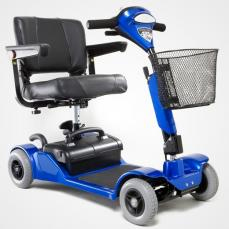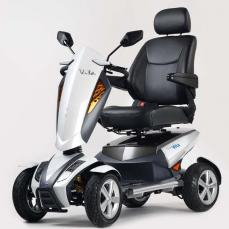- Folding/portable scooters
- 4 mph scooters
- 6 mph scooters
- 8 mph scooters
- 3 wheel scooters
- 4 wheel scooters
- 5 wheel scooters
In law, mobility scooters are divided into ‘class 2’ and ‘class 3’ vehicles based on where they’re intended to be used. There are some key differences between the two classes.
Class 2 scooters can only be used on footpaths, pavements, and to cross roads. They have a maximum speed of 4mph (6.4kph).
- Can be used indoors
- Small, lightweight and compact
- Basic driving controls
- Some can be dismantled/folded up to fit into a car boot
- Shorter battery life means they travel shorter distances
Class 3 scooters can be used on roads and pavements. The maximum speed limit of these vehicles is 4mph on the pavement and 8mph (12.8kph) on the road. You must be 14 years old or over to drive a class 3 vehicle.
- For outdoor use
- Large and robust
- Equipped with a rear-view mirror and reflectors, and extra controls for driving on roads: indicators, headlights, a horn and hazard lights
- Require a ramp or lift to transport them into a vehicle
- Longer battery life and tougher tyres means they can travel longer distances
Dimensions
Mobility scooters vary in length, width and height. It’s important to think about how big you need it to be to sit on comfortably – will you have space to stretch out your legs? You should also consider where you will store your scooter and where you will use it.
Dismantled class 2 scooter
The scooter’s ‘turning radius’ is related to its size. The turning radius determines the amount of space the scooter needs to turn around completely. A small scooter with a small turning radius will be easier to use indoors. Scooters with three wheels have a smaller footprint and are easier to manoeuvre, but they may be less stable. There are often size and turning radius restrictions when travelling on public transport. Some scooters dismantle or fold up so they can be stored or transported more easily.




